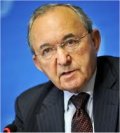 By: Richard J. Goldstone,
Hammarskjold Commission Member, Former Justice of the Constitutional Court of
South Africa, First Chief Prosecutor of the International Criminal Tribunal for
Yugoslavia, and Regular Columnist, International Judicial Monitor
By: Richard J. Goldstone,
Hammarskjold Commission Member, Former Justice of the Constitutional Court of
South Africa, First Chief Prosecutor of the International Criminal Tribunal for
Yugoslavia, and Regular Columnist, International Judicial Monitor
Dag
Hammarskjold is said by many to have been the best Secretary-General in the
history of the United Nations. He died on 18 September 1961 when the plane in
which he was flying crashed some nine miles from Ndola Airport in what was then
Northern Rhodesia and is now Zambia. In Ndola Hammarskjold was set to meet with
Moise Tshombe, the leader of the then breakaway province of Katanga. A war was
under way between United Nations Forces who had been authorized to end the
unilateral independence of Katanga and ensure its reincorporation into the
Congo that had then recently been granted independence.
During 1961
and 1962 there were three inquiries into the cause of the crash. Two days after
the crash, the Rhodesian Federal Department of Civil Aviation set up an air
accident investigation as required by the international civil aviation
authorities. Its conclusion was that “the aircraft’s approach to the airport
had been normal and correct, except that it was about 1,700 feet lower than it
should have been.” It concluded that the evidence did not allow for a
‘specific’ or ‘definitive’ cause for the crash. The second inquiry was launched
by the Government of the Rhodesian Federation. It ascribed the crash to pilot
error. The third inquiry was set up by the United Nations itself. Like the
first inquiry it was unable to ascribe a cause for the crash but could not
exclude sabotage or attack.
On 26 October
1962, the General Assembly of the United Nations passed a resolution in which
it instructed the Secretary-General to bring to its attention any evidence that
might come to light justifying the reopening of the inquiry.
In 1961 there
were a number of interests that would have been served by the death of the
Secretary-General. In particular there were white supremacists who, for good
reason, feared that the independence of the Congo would be the beginning of the
end of colonialism in southern Africa. There were also the financial interests
of major mining companies who benefited from the mineral riches of Katanga.
Some European powers and the United States feared that independence for the
Congo would provide an entry point for the Soviet Union to gain a foothold in
Southern Africa.
Interest in
the death of Dag Hammarskjold was rekindled in 2011, when Dr. Susan Williams,
of London University, published a book entitled Who Killed Hammarskjold? Her wide and careful researches brought to light evidence that tended to
support the conclusion that the crash was no accident but rather the result of
foul play. However, much of that evidence was contradictory and some was
suspect and unreliable. Dr. Williams was unable to ascribe any one cause as
more probable than another. Her book, however, moved private individuals from a
number of countries to establish an independent, unofficial commission of
inquiry to provide an opinion on whether there was new evidence that would
justify the United Nations reopening its 1962 inquiry.

 International
Judicial Monitor
International
Judicial Monitor